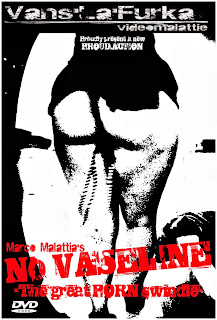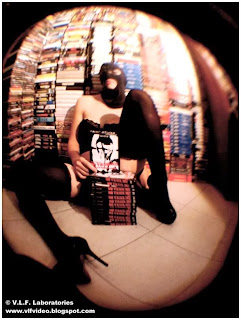“How Dark is Darkness?” An essay by Phil Barrington
The Pre-Digital Origins
From the earliest moments in history of photography and film there have been examples of imagery, deemed both in contemporary times and still to this day to be of an extreme and shocking nature. Famous early examples range wildy from shots of pre-WWI beheadings in the Far East (captured before the spinning airborne head hits the ground), Edison’s death-by-electrocution of an elephant, and moving forward slightly to Buñuel’s slicing of an eyeball and flickering hardcore pornography from the “What the Butler Saw” era.
The dawn of home projectors and cinefilm in the 1950s/60s brought with it the period of early stag films leading up to the formation of Color Climax, the “nudie roughie” shorts and much worse; the most extreme examples of the “roughie” kind possibly being “Kilroy Was Here” and the infamous farmyard antics of the tragic Bodil Joensen, subsequently VHS-copied into infinity until the grain and low quality of the taped footage makes the outrageous zoophilia action almost abstract in its lack of detail and blurred, jittery movements.
By this time Warhol had also released a whole slew of mostly silent movies focussing on symbolic and literal interpretations of homosexual and heterosexual acts interspersed with horses, S&M and drug-induced freakouts before leading on to the 1970s era of experimental and extreme performance art.
The lurid and controversial sexual performances by COUM Transmissions / Throbbing Gristle in the UK during the mid-1970s, especially Cosey Fanni Tutti‘s performances, gave the arthouse audience a delirious mix of pagan symbology, blood, semen, used tampons, staged mutilation, S&M and knives as men and women writhed around in their own juices on a gallery floor. Even Germaine Greer got in on the act and posed for shots with a very eager snake…or so I hear.
Across the Atlantic at this time, we had a host of post-Vietnam performance artists seemingly turning inward and mutilating themselves, nailing each other to Volkswagen Beetles at the drop of hammer.
Then the glorious visual excesses of the 1980s assault our increasingly jaded senses even more, with handheld VHS video cameras taking the lead, from Derek Jarman‘s almost druidic short films, Psychic TV Transmissions available via PO Box order and, over in New York, the Cinema of Transgression taking full flight with artists such as the Tutti-esque Lydia Lunch, Richard Kern, Nick Zedd and Bob Flanagan exploring the outer realms of physical and sexual expression – often putting themselves in serious physical danger in the process.
Going Online
For those whose synapses were prickled by extreme performance art there seemed nowhere else to go. We’d seemingly seen it all, hadn’t we? From Turbo Tom taking scissors to his eyeballs onstage in front of probably only a handful of people, to fringe personalities extolling the virtues of mass slaughter and sexual oblivion. That was until the late-1990s ushered in the era of the World Wide Web, with its myriad real-death footage immediately available to gross-out and alarm us all; extreme pornography just a click away from extreme torture footage and bodily modification clips, blurring all such acts into a new kind of “ultra-realist” Dark Art with the likes of Joel-Peter Witkin, Anton LaVey and Robert Mapplethorpe seemingly becoming the elder figureheads for these new dark shamans of an online, forever connected world.
Quite dull-looking and unstylised photographs began to circulate of a chinese performance artist Zhu Yu protesting against rampant consumerism (probably) by actually (and badly, by the looks of it) cooking and eating parts of a dead human fœtus reached a kind of creative nadir – ever-circulated on online forums and Jackass-meets-Mondo sites like rotten.com, EFukt and Goatse, ad nauseum. As surprisingly and as shockingly banal and boring as this unrelentless extreme footage quickly became, it did have its share of infamous “stars” (Mr. Hands, HotKinkyJo, etc.) and, inevitably, real-life murderers were given a platform to share their newest atrocities with the world (I’m thinking of Luka Magnotta here).
This “underground” of the internet’s murky artistic and grand guignol fetishes quickly became overground as teens began to circulate such footage amongst themselves on their pre-smart mobile phone devices, with clips such as 2 Girls 1 Cup almost becoming a household phenomenon.
The next development in the dawn of the digital era was the evolution of Hi-Def digital film, with self-made directors and make-up artists like Lucifer Valentine and the Toetag Pictures team now being able to create professional-looking and ultra-realistic extreme performance films like a showreel of effects, with often not-so professional “actors”; kind-of resembling a Blu-Ray generation of COUM/Transgression film-makers with a Warhol’s Factory-era stock of glazed-looking actors and actresses and an over-the-top headache-inducing abundance of Thrash Metal content. The zenith of this era is surely the truly astounding ‘August Underground‘ trilogy of films and ‘Snuff 102‘ – all informed by the endless clips of real-death footage and mondo films of yore, and all informed by the excesses of both the transgressive period of the 1980s and the latter-day sexual fetish websites.
Nowadays, in post-9/11 times? Almost every fetish and artistic angle of every kind of “performance” is well-tailored for, each HQ website so finely tuned to the demands of surfer’s peccadillos that everything all seems so safe and compartmentalised in their consumerist cages, with great care taken with regards to visual ultra-clarity, lighting and setting.
There’s A Glitch
But, as each creative era seems to speed past after only a handful of years these days, there has certainly been a turning point – even if it’s just an audio-visual one. Like it or not, as far as digital art is concerned (including DSLRs, digital camcorders and digital genres of music) We are now part of the Glitch Movement.
From the hesitant, distorted beats and vocals of the latest popular electronic music, to growing genres of Hauntology and experimental retro-industrial music to a whole host of apps and codecs across all the software operating systems, the degradation of the form is clearly apparent – and it’s “trending”.
We once clamboured for the utmost audio-visual quality of our digital entertainment, no matter how seedy or distasteful the actual content was. And, in this Hi-Def world we live in, we have clearly won. We now, however, find ourselves exploring a multitude of all previous recording devices and their visual “problems and quirks”. For, in the rush for perceived perfection, we realise that we somehow miss the textures and “feel” of such organic forms as Cine film, VHS, Betamax, Polaroid, cassette field recordings, vinyl records and other such archaic forms of audio-visual expression.
We miss the vagueness of 6th-generation bootleg quality sound and picture. Whether it be the eternal human love for nostalgia, or our keenness to feel and sense art rather than see with ultra-realism, in this post-Instagram world we find ourselves at a creative crossroads. And, as far as extreme performance art goes, Marco Malattia is showing us the road forward – and it’s an ever-evolving path of darkness.
No Vaseline
V.L.F. Laboratories, led by Marco Malattia and his dedicated team of audio-visual performance artist collaborators and models, explore this glitch world we live in with their own ethos and manifesto, re-capturing “the vitality of the spectacle” through a heady mix of ancient recording devices, filters and black noise distortion in his “No Vaseline” film – the vitality reflected throughout his fast-paced second major full-length feature by the acts contained within it; Not so much sexual perversion but extreme sexual endurance and performance art in excelsis. Don’t get me wrong, there is lots of fucking in this film. But, as the old-school punk “The Great Porn Swindle” tagline of the film suggests, if you’re looking to purchase some bog-standard porn here, you’ll feel robbed. For there is so much more going on in this film than those who flinch away from the screen, expecting vanilla porn, may realise.
The film is, broadly speaking, a series of distorted vignettes with masked females and Marco exploring their intimacy against a host of industrial backdrops and through a wide variety of sexual acts that you wouldn’t find on your average ‘honeymoon’ video. I won’t describe the acts here, as you need to see them for yourself and, besides, a sheer descriptive list of acts performed would rob them of their astonishing power.
It may be fair to say that 90% of the sexual intimacy seen here is probably too hardcore for most people (even in this jaded online age), though on rare occasions the truly intense atmosphere subtly turns playful – with occasional whispered dialogue, a brief smile and break-of-character-role permitted, with some gallows humour evident too – if you look for it beyond the ferocious main set-pieces here; I’m thinking the bathtub scene, a Serrano-esque Urine Jar scene, and a spaghetti-based act that you won’t see in a Dolmio advertisement any time soon.
There are many areas within Marco’s body of work which make it stand head and shoulders above similar extreme works by his peers (though there are less directors out there doing this kind of strong performance material than you may think), some being his great choice and construction of location backdrops, the perfect pacing, his use of physical threat often seeming very real and on-the-edge indeed (giving the general sense that anything is going to happen – and it’s going to be very bad indeed when it does), his great choice of female performance artists including the beautiful, increasingly infamous and gleeful Helga Retard making regular appearances, and the often pounding industrial soundtrack making a further impact on the proceedings – not the over-used and unintentionally hilarious thrash/death metal in other people’s works but intelligent glitch-industrial-electro cacophonies here in Marco’s World performed by ZeroGravityToilet, sometimes slightly reminiscent of the cassette-mangling retro-noise of Atrax Morgue, another extreme undergound performer named Marco, who committed suicide in 2007.
Which brings us indeed to “Marco’s World”; one marred by numb industrial decay, a rotten world bereft of life when he ventures outside to film around destroyed factories, broken-down buildings and crushed cars, and one of full-on violent passion when intimate with the models – like a series of couplings reacting against such a dead world by saying WE ARE ALIVE HERE, though not necessarily “alive and well”. His manifesto clearly refers to these sexual gnosis acts as being the opposite to the outside world of cold reality;
“reconstructing a parallelism where the image replaces the body and the person placing it eternally within a symbolic context where what is excluded represents the negative, repetitive and sterile aspect of reality.”
There is so much passion evident here and, although the director may himself disagree, I DO personally see a narrative structure in “No Vaseline” instead of simply a series of extremely powerful sexual performance art vignettes.
In essence, “No Vaseline” is a multi-textured audio-visual diary of writhing bodies and flowing coloured fluids, shot by a set of individuals finding their way, spiritually (some may think of satanism, but it seems the spiritual hub here is the worship of Kali Yuga) as well as sexually, through the rubble of a contemporary society long-since broken down. Physical ejaculations here are also mirrored symbolically by violent outbursts, I think, including a scene where Marco attacks a car by throwing bricks at the shattering windscreen – with Helga behind the camera stuck inside!
It seems to me this is a video diary of lost souls findind themselves trapped together with an increasingly desperate need to FEEL and to SENSE things through such extreme sexual and violent performances – to BELIEVE in something, in defiance of a world that no longer serves any true purpose or compassion in and of itself.
This may sound like “No Vaseline” could be quite a depressingly grim viewing, like an Eraserhead-by-way-of-Marquis De Sade – but it is the exact opposite; if you can handle the truly rough ride, this film is an outrageously life-affirming piece of sexual performance art to rival the canon of other such works as explored at the start of this essay, often as sexy as hell, showing passionate people rebelling and rebuilding their lives on their own, and on their own terms.
And you can’t get more punk than that.
Phil Barrington
December 2013,
East Anglia, UK.

.jpg)





